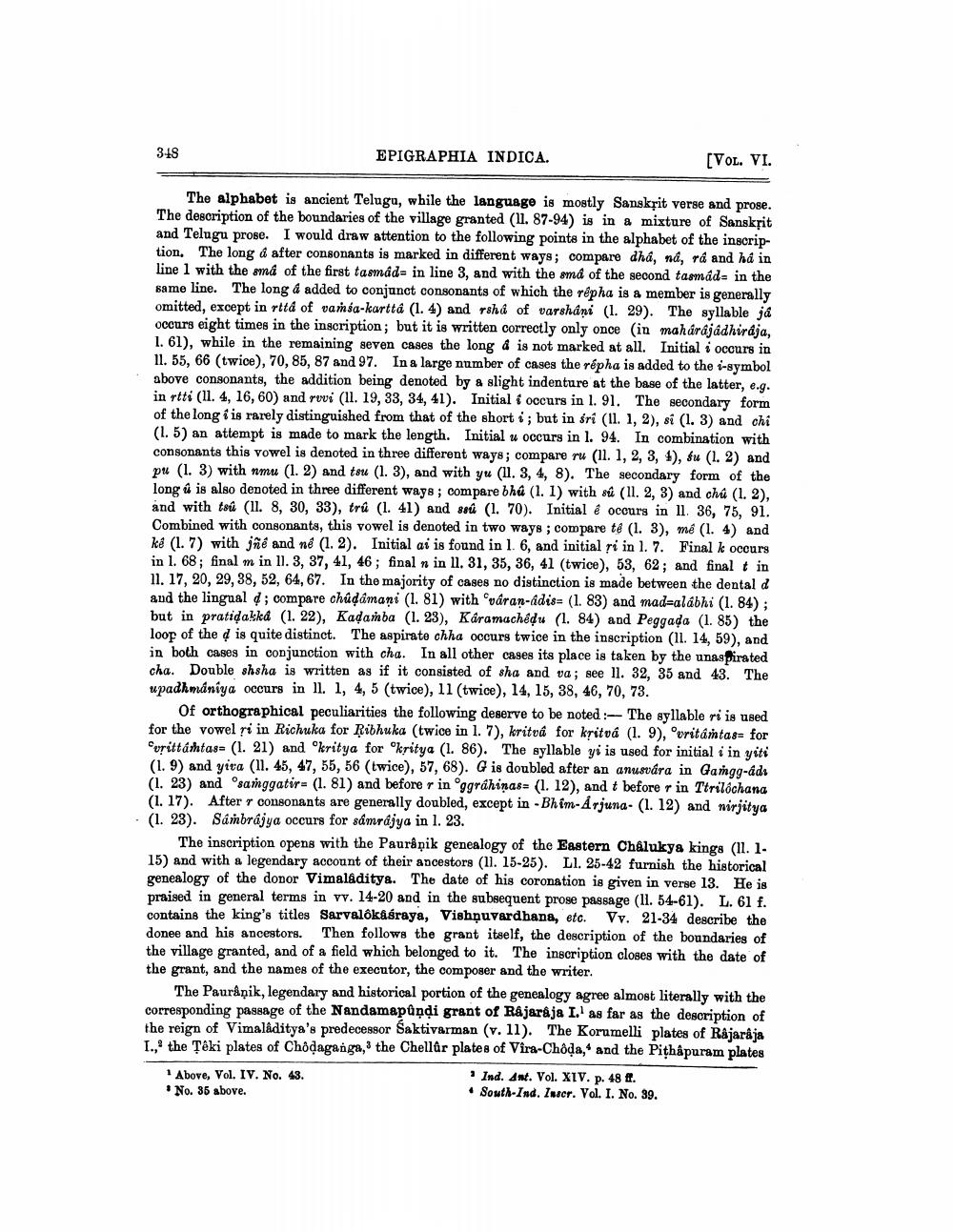________________
318
EPIGRAPHIA INDICA.
(VOL. VI.
The alphabet is ancient Teluga, while the language is mostly Sanskřit verse and prose. The description of the boundaries of the village granted (11. 87-94) is in a mixture of Sansksit and Telugu prose. I would draw attention to the following points in the alphabet of the inscription. The long & after consonants is marked in different ways; compare dhå, nå, rd and há in line 1 with the små of the first tasmad- in line 3, and with the små of the second tasmade in the same line. The long & added to conjunct consonants of which the rêpha is a member is generally omitted, except in rttá of varsa-kartta (1. 4) and rhå of varshani (1. 29). The syllable ja occurs eight times in the inscription; but it is written correctly only once (in maharajadhiraja, 1. 61), while in the remaining seven cases the long d is not marked at all. Initial i occurs in 11. 55, 66 (twice), 70, 85, 87 and 97. In a large number of cases the répha is added to the i-symbol above consonants, the addition being denoted by a slight indenture at the base of the latter, e.g. in rtti (11. 4, 16, 60) and roui (11. 19, 33, 34, 41). Initial occurs in 1. 91. The secondary form of the long iis rarely distinguished from that of the short i; but in sri (11. 1, 2), si (1.3) and chi (1.5) an attempt is made to mark the length. Initial » occurs in l. 94. In combination with consonants this vowel is denoted in three different ways; compare ru (11. 1, 2, 3, 4), $u (1.2) and put (1. 3) with nmu (1.2) and tsu (1. 3), and with yu (11.3, 4, 8). The secondary form of the long û is also denoted in three different ways; compare bhů (1.1) with sú (11. 2, 3) and chú (1.2), and with trú (11.8, 30, 33), trú (1. 41) and ssú (1. 70). Initial é occurs in 11. 36, 75, 91. Combined with consonants, this vowel is denoted in two ways; compare t& (1. 3), mé (1. 4) and ka (1. 7) with jñe and né (1.2). Initial ai is found in 1. 6, and initial si in l. 7. Final k occurs in l. 68: final m in 11. 3, 37, 41, 46; final n in 11. 31, 35, 36, 41 (twice), 53, 62; and final t in 11. 17, 20, 29, 38, 52, 64, 67. In the majority of cases no distinction is made between the dental d and the lingual d; compare chudamani (1. 81) with varan-adis= (1. 83) and mad=alábhi (1. 84); but in pratidakka (1. 22), Kadamba (1. 23), Karamachódu (1. 84) and Peggada (1. 85) the loop of the dis quite distinct. The aspirate chha occurs twice in the inscription (11. 14, 59), and in both cases in conjunction with cha. In all other cases its place is taken by the unas pirated cha. Double shsha is written as if it consisted of sha and va; see 11. 32, 35 and 43. The upadhmaniya occurs in 11. 1, 4, 5 (twice), 11 (twice), 14, 15, 38, 46, 70, 73.
Of orthographical peculiarities the following deserve to be noted - The syllable ri is used for the vowel ri in Richuka for Ribhuka (twice in 1. 7), kritvå for kritva (1. 9), vritämtasfor Curittathtas= (1. 21) and "kritya for "kritya (1. 86). The syllable yi is used for initial i in yiti (1.9) and vita (11. 45, 47, 55, 56 (twice), 57, 68). G is doubled after an anusvåra in Gangg-ads (1. 23) and sanggatir= (1. 81) and before r in oggrahinas- (1. 12), and t before r in Ttrilôchana (1. 17). After r consonants are generally doubled, except in - Bhim-Arjuna- (1. 12) and nirjitya (1. 23). Sámbrájya occurs for samrájya in 1. 23.
The inscription opens with the Paurápik genealogy of the Eastern Chalukya kings (11. 1. 15) and with a legendary account of their ancestors (11. 15-25). Ll. 25-42 furnish the historical genealogy of the donor Vimaladity. The date of his coronation is given in verse 13. He is praised in general terms in vv. 14-20 and in the subsequent prose passage (11. 54-61). L. 61 f. contains the king's titles Sarvalókásraya, Vishņuvardhana, etc. Vv. 21-34 describe the donee and his ancestors. Then follows the grant itself, the description of the boundaries of the village granted, and of a field which belonged to it. The inscription closes with the date of the grant, and the names of the executor, the composer and the writer.
The Pauranik, legendary and historical portion of the genealogy agree almost literally with the corresponding passage of the Nandamapundi grant of Rajaraja I. as far as the description of the reign of Vimaladitya's predecessor Saktivarman (v. 11). The Korumelli plates of Rajaraja I.,' the Têki plates of Chôdaganga, the Chellûr plates of Vira-Chôda, and the Pithapuram plates
1 Above, Vol. IV. No. 43. No. 35 above.
· Ind. Ant. Vol. XIV. p. 48 . • South-Ind. Inscr. Vol. I. No. 39.




